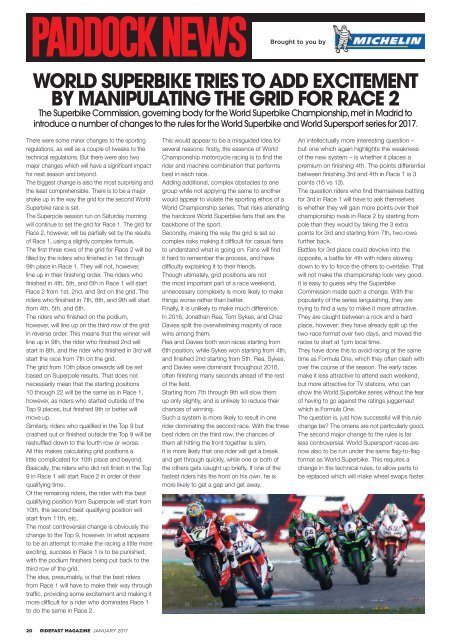1701 RF final
You also want an ePaper? Increase the reach of your titles
YUMPU automatically turns print PDFs into web optimized ePapers that Google loves.
PADDOCK NEWS<br />
Brought<br />
to you by<br />
WORLD SUPERBIKE TRIES TO ADD EXCITEMENT<br />
BY MANIPULATING THE GRID FOR RACE 2<br />
The Superbike Commission, governing body for the World Superbike Championship, met in Madrid to<br />
introduce a number of changes to the rules for the World Superbike and World Supersport series for 2017.<br />
There were some minor changes to the sporting<br />
regulations, as well as a couple of tweaks to the<br />
technical regulations. But there were also two<br />
major changes which will have a significant impact<br />
for next season and beyond.<br />
The biggest change is also the most surprising and<br />
the least comprehensible. There is to be a major<br />
shake up in the way the grid for the second World<br />
Superbike race is set.<br />
The Superpole session run on Saturday morning<br />
will continue to set the grid for Race 1. The grid for<br />
Race 2, however, will be partially set by the results<br />
of Race 1, using a slightly complex formula.<br />
The first three rows of the grid for Race 2 will be<br />
filled by the riders who finished in 1st through<br />
9th place in Race 1. They will not, however,<br />
line up in their finishing order. The riders who<br />
finished in 4th, 5th, and 6th in Race 1 will start<br />
Race 2 from 1st, 2nd, and 3rd on the grid. The<br />
riders who finished in 7th, 8th, and 9th will start<br />
from 4th, 5th, and 6th.<br />
The riders who finished on the podium,<br />
however, will line up on the third row of the grid<br />
in reverse order. This means that the winner will<br />
line up in 9th, the rider who finished 2nd will<br />
start in 8th, and the rider who finished in 3rd will<br />
start the race from 7th on the grid.<br />
The grid from 10th place onwards will be set<br />
based on Superpole results. That does not<br />
necessarily mean that the starting positions<br />
10 through 22 will be the same as in Race 1,<br />
however, as riders who started outside of the<br />
Top 9 places, but finished 9th or better will<br />
move up.<br />
Similarly, riders who qualified in the Top 9 but<br />
crashed out or finished outside the Top 9 will be<br />
reshuffled down to the fourth row or worse.<br />
All this makes calculating grid positions a<br />
little complicated for 10th place and beyond.<br />
Basically, the riders who did not finish in the Top<br />
9 in Race 1 will start Race 2 in order of their<br />
qualifying time.<br />
Of the remaining riders, the rider with the best<br />
qualifying position from Superpole will start from<br />
10th, the second best qualifying position will<br />
start from 11th, etc.<br />
The most controversial change is obviously the<br />
change to the Top 9, however. In what appears<br />
to be an attempt to make the racing a little more<br />
exciting, success in Race 1 is to be punished,<br />
with the podium finishers being put back to the<br />
third row of the grid.<br />
The idea, presumably, is that the best riders<br />
from Race 1 will have to make their way through<br />
traffic, providing some excitement and making it<br />
more difficult for a rider who dominates Race 1<br />
to do the same in Race 2.<br />
This would appear to be a misguided idea for<br />
several reasons: firstly, the essence of World<br />
Championship motorcycle racing is to find the<br />
rider and machine combination that performs<br />
best in each race.<br />
Adding additional, complex obstacles to one<br />
group while not applying the same to another<br />
would appear to violate the sporting ethos of a<br />
World Championship series. That risks alienating<br />
the hardcore World Superbike fans that are the<br />
backbone of the sport.<br />
Secondly, making the way the grid is set so<br />
complex risks making it difficult for casual fans<br />
to understand what is going on. Fans will find<br />
it hard to remember the process, and have<br />
difficulty explaining it to their friends.<br />
Though ultimately, grid positions are not<br />
the most important part of a race weekend,<br />
unnecessary complexity is more likely to make<br />
things worse rather than better.<br />
Finally, it is unlikely to make much difference.<br />
In 2016, Jonathan Rea, Tom Sykes, and Chaz<br />
Davies split the overwhelming majority of race<br />
wins among them.<br />
Rea and Davies both won races starting from<br />
6th position, while Sykes won starting from 4th,<br />
and finished 2nd starting from 5th. Rea, Sykes,<br />
and Davies were dominant throughout 2016,<br />
often finishing many seconds ahead of the rest<br />
of the field.<br />
Starting from 7th through 9th will slow them<br />
up only slightly, and is unlikely to reduce their<br />
chances of winning.<br />
Such a system is more likely to result in one<br />
rider dominating the second race. With the three<br />
best riders on the third row, the chances of<br />
them all hitting the front together is slim.<br />
It is more likely that one rider will get a break<br />
and get through quickly, while one or both of<br />
the others gets caught up briefly. If one of the<br />
fastest riders hits the front on his own, he is<br />
more likely to get a gap and get away.<br />
An intellectually more interesting question –<br />
but one which again highlights the weakness<br />
of the new system – is whether it places a<br />
premium on finishing 4th. The points differential<br />
between finishing 3rd and 4th in Race 1 is 3<br />
points (16 vs 13).<br />
The question riders who find themselves battling<br />
for 3rd in Race 1 will have to ask themselves<br />
is whether they will gain more points over their<br />
championship rivals in Race 2 by starting from<br />
pole than they would by taking the 3 extra<br />
points for 3rd and starting from 7th, two rows<br />
further back.<br />
Battles for 3rd place could devolve into the<br />
opposite, a battle for 4th with riders slowing<br />
down to try to force the others to overtake. That<br />
will not make the championship look very good.<br />
It is easy to guess why the Superbike<br />
Commission made such a change. With the<br />
popularity of the series languishing, they are<br />
trying to find a way to make it more attractive.<br />
They are caught between a rock and a hard<br />
place, however: they have already split up the<br />
two-race format over two days, and moved the<br />
races to start at 1pm local time.<br />
They have done this to avoid racing at the same<br />
time as Formula One, which they often clash with<br />
over the course of the season. The early races<br />
make it less attractive to attend each weekend,<br />
but more attractive for TV stations, who can<br />
show the World Superbike series without the fear<br />
of having to go against the ratings juggernaut<br />
which is Formula One.<br />
The question is, just how successful will this rule<br />
change be? The omens are not particularly good.<br />
The second major change to the rules is far<br />
less controversial. World Supersport races are<br />
now also to be run under the same flag-to-flag<br />
format as World Superbike. This requires a<br />
change in the technical rules, to allow parts to<br />
be replaced which will make wheel swaps faster.<br />
20 RIDEFAST MAGAZINE JANUARY 2017
















